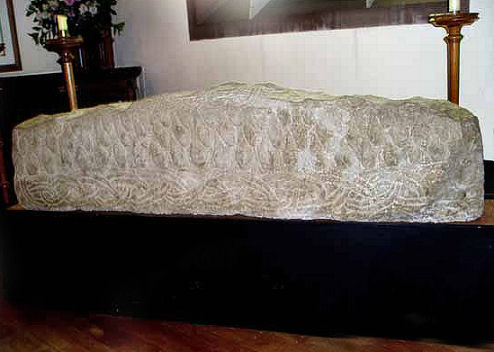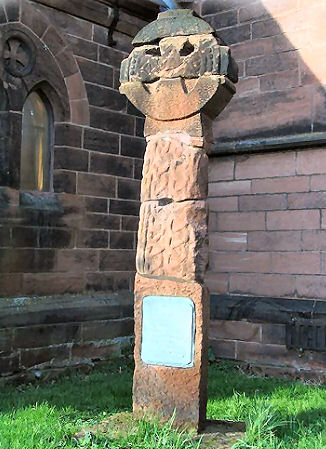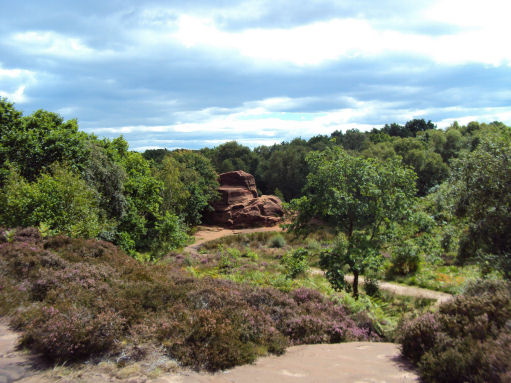Viking Wirral
 The Vikings began raids on the Wirral towards the end of the ninth century, travelling from Ireland, they began to settle along the River Dee side of the peninsula and along the sea coast.
The Vikings began raids on the Wirral towards the end of the ninth century, travelling from Ireland, they began to settle along the River Dee side of the peninsula and along the sea coast.
Ancient Irish annals record the settlement of the Wirral by Vikings led by one Ingimund, who had been expelled from Ireland in around 902 and gained permission from Ethelfleda, Lady of Mercia and daughter of King Alfred the Great, to settle peacefully on the peninsula. The boundary of the old Norse colony is believed to have passed south of Neston and Raby (the vilage's name translates from Old Norse as 'boundary settlement') and along Dibbinsdale.
Archeology
Wirral boasts a wealth of Viking Age archaeology. In the 19th century Viking artefacts were discovered at Meols as coastal erosion exposed ancient settlements, these finds included coins, Hiberno-Norse pins, brooches, part of a drinking horn and what appear to be weapons from a possible pagan burial. Remains of an elliptically shaped Viking house with an amber bead and other finds have been found at Irby. Viking cross fragments have been found at Hilbre Island, West Kirby, Woodchurch and Bromborough.
The famous "Hogback" (the name Hogback referring to its curving shape) grave cover stone which is kept at St. Bridget's Church in West Kirby, (pictured below left) consists of hard grey sandstone, a type of stone not found locally and is of Anglo-Norse origin, the stone dates from the early eleventh century. A sandstone Anglo- Viking preaching cross dating from around the tenth century stands in the churchyard of St Barnabas Church at Bromborough.
In the late 20th century the remains of damaged cross fragments were found in the basement of Neston parish church. They were identified as of Viking origin and of being part of at least three separate crosses, they depict events in the life of a Viking couple who once lived there. In 2004, a 10th century viking Hogback Stone was discovered in a garden at Bidston, the stone, which was probably a grave marker, depicts two fanged beasts, believed to be bears, whose tongues are interlaced in an elaborate design with a three fold knot between their paws.
 A viking vessel measuring 30ft long by 5ft wide is believed to lie beneath 6-10ft of clay by the Railway Inn in Meols. Professor Stephen Harding, of the University of Nottingham, is now seeking European funding to pay for an excavation, Prof Harding used ground penetrating radar (GPR) equipment to pinpoint the ship's exact location, tracing the outline of an object which matches the scale and shape of a longship, possibly from the time Vikings settled in Meols.. He believes the vessel could be carefully removed.
A viking vessel measuring 30ft long by 5ft wide is believed to lie beneath 6-10ft of clay by the Railway Inn in Meols. Professor Stephen Harding, of the University of Nottingham, is now seeking European funding to pay for an excavation, Prof Harding used ground penetrating radar (GPR) equipment to pinpoint the ship's exact location, tracing the outline of an object which matches the scale and shape of a longship, possibly from the time Vikings settled in Meols.. He believes the vessel could be carefully removed.
Prof Harding has said: "Although we still don't know what sort of vessel it is, it's very old for sure and its Nordic clinker design, position and location suggests it may be a transport vessel from the Viking settlement period, if not long afterwards. Meols is known to have one of Britain's best preserved Viking settlements, buried deep beneath the village and nearby coastal defences."It is some distance from the present coastline and probably the old one too. "It might have got to its present position after flooding and sinking into an old marsh."
The ship was first uncovered by a workman in 1938 when the Railway Inn was being demolished and rebuilt further from the road, the site of the old pub being made into a car park. Sadly, the workman was advised by the foreman to cover the ship over again so as not to delay construction. The workers son handed a drawing of the discovery made at the time to the local museum and authorities in 1991. Whilst Viking boat burial sites have been uncovered in the UK before, the wooden vessels have always been rotted away, leaving only their more durable contents. But the Wirral boat is preserved in waterlogged clay, and thought to be almost completely intact.
Thingwall- the Viking Parliament
The Vikings introduced their own local government system with a parliament at Thingwall, which name derives from the Old Norse þing vollr, meaning 'assembly field'. The small 205 ft (63 m) high hill now known as Cross Hill was a major meeting place or parliament for Viking communities from the entire northern half of the Wirral peninsula and possibly also from outlying areas at Helsby, Whitby and Talacre on the other side of the River Dee.
Bromborough- a candidate for the epic Battle of Brunanburh
 The large village of Bromborough, on the east of the Peninsula, is a strong candidate for the site of the epic Battle of Brunanburh, a great English victory over the Vikings. The battle was fought in 937, by an Anglo-Saxon army under the command of Æthelstan, King of England, and his brother Edmund against the combined Viking armies of Olaf III Guthfrithson, the Norse-Gael King of Dublin, Constantine II, King of Scots, and Owen I, King of Strathclyde. Brunanburh has been called "the greatest single battle in Anglo-Saxon history before Hastings".
The large village of Bromborough, on the east of the Peninsula, is a strong candidate for the site of the epic Battle of Brunanburh, a great English victory over the Vikings. The battle was fought in 937, by an Anglo-Saxon army under the command of Æthelstan, King of England, and his brother Edmund against the combined Viking armies of Olaf III Guthfrithson, the Norse-Gael King of Dublin, Constantine II, King of Scots, and Owen I, King of Strathclyde. Brunanburh has been called "the greatest single battle in Anglo-Saxon history before Hastings".
The Annals of Ulster record 'A huge war, lamentable and horrible, was cruelly waged between the Saxons and Norsemen. Many thousands of Norsemen beyond number died although King Anlaf escaped with a few men. While a great number of the Saxons also fell on the other side, Athelstan, king of the Saxons, was enriched by the great victory.' Egil's Saga, a story which tells of the battle, may have referred to Wirral as Wen Heath, Vínheíþr in Icelandic.
The Annals of Ulster describes the battle ' A huge war, lamentable and horrible, was cruelly waged between the Saxons and Norsemen. Many thousands of Norsemen beyond number died although King Anlaf escaped with a few men. While a great number of the Saxons also fell on the other side, Athelstan, king of the Saxons, was enriched by the great victory.' The famous poem about the Battle of Brunanburh in the Anglo-Saxon Chronicle records the deaths of five kings and seven earls-
Five lay still
on that battlefield –
young kings by swords put to sleep – and seven also
of Anlaf’s earls, countless of the army,
of sailors and Scotsmen. There was put to flight
the Northmen’s chief, driven by need to the ship’s prow with a little band.
The name derives from Old English Brunanburh, which means 'Brun's fort'. While doubt will always remain as to the location of the battle, the evidence of history, folklore studies, and literature all suggest Bromborough to be the most likely contender. Although the precise location on Wirral for the main battle site is not known with certainty it is thought that the thick of the fighting could have taken place in the Bebington-Brimstage region.
Viking Place Names
Evidence of Norse settlement in Wirral can be seen from its place names, such as the '-by' (meaning "village" in Scandinavian languages) suffix, which is common in the area i.e, Helsby - hjalli-byr village at the ledge, Raby, from the Old Norse ra-byr meaning boundary or border settlement, Frankby (Franki's settlement), Greasby (wooded stronghold). Tranmere comes from trani melr ("cranebird sandbank"), Meols derives from the Old Norse for sandbanks or sandhills. West Kirby, or West Church Settlement, the settlement of Vestri Kirkjubaer in Iceland has exactly the same name, which translates from Icelandic as West Kirby.
 Thor’s Stone , also known as Thor’s Rock, on Thurstaston Common, (pictured left) a large red sandstone outcrop of unusual shape and appearance, is a place shrouded in legend. Early Viking settlers are purported to have held religious ceremonies there in honour of the thunder god Thor. Further examples include Heskeths field (which derives from hestaskeið = horse race track), Storeton is old Norse for great farmstead or farmstead by a young wood. Claughton means hamlet on a hillock, Neston (farmstead at the promontory), Hinderton (village lying at the back), Arrowe (shieling or hill pasture), Denhall (Danes' well), Gayton (goat farmstead) and Ness (promontory, a lost feature of the coast).
Thor’s Stone , also known as Thor’s Rock, on Thurstaston Common, (pictured left) a large red sandstone outcrop of unusual shape and appearance, is a place shrouded in legend. Early Viking settlers are purported to have held religious ceremonies there in honour of the thunder god Thor. Further examples include Heskeths field (which derives from hestaskeið = horse race track), Storeton is old Norse for great farmstead or farmstead by a young wood. Claughton means hamlet on a hillock, Neston (farmstead at the promontory), Hinderton (village lying at the back), Arrowe (shieling or hill pasture), Denhall (Danes' well), Gayton (goat farmstead) and Ness (promontory, a lost feature of the coast).
Viking DNA
Recent Y-DNA research has also revealed the genetic trail left by Vikings in the Wirral, specifically relatively high rates of the Haplogroup R1a, associated in Britain with Norse ancestry.‘Viking DNA: The Wirral and West Lancashire Project’ is the culmination of several years of research by Wirral-raised Professor Steve Harding from the University of Nottingham, Professor Mark Jobling and Dr Turi King from the University of Leicester. It showcases the power of modern DNA methods for probing ancestry using the North West of England as an example and revealed that up to half of the DNA from old Wirral families is of Norse origin, about the same as modern Orkney, well known for its Viking links.
From generation to generation, DNA of the male Y-chromosome is passed along the paternal ancestry, the team of researchers took advantage of the fact that surnames are also passed along the same lines. The method proved to be especially powerful being applied not to individuals but whole populations. Thus the group of volunteers had to be selected according to certain areas and specific surnames present in these areas at least prior to 1600. DNA tests on around 100 men from the area who had local surnames dating back hundreds of years. Some names were sourced from a tax register from the time of King Henry VIII, others from lists of alehouse and criminal records, and a list of people who contributed to the stipend of a priest. Scientists found two men from Meols who shared identical historical links to Scandinavia during DNA studies, their strongest DNA link was to Gotland, an island off the east coast of Sweden.
The Anglo-Saxon kingdom of Mercia
